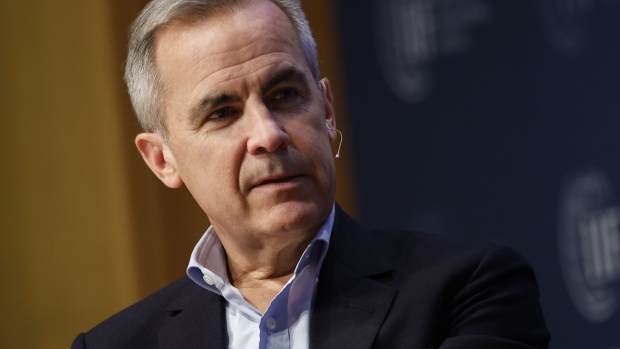Oct 14, 2022
Banks Try Quiet Quitting on Net Zero
, Bloomberg News

(Bloomberg) -- For some bankers, net-zero is like a new year’s resolution—a pledge one makes and often breaks before a year has passed.
Several of the largest banks, including JPMorgan, Bank of America, and Morgan Stanley, headed into the 2021 United Nations Climate Change Conference (COP26) as members of the world’s biggest zero-carbon finance club. Their membership in the Glasgow Financial Alliance for Net Zero (GFANZ), a group of roughly 500 financial sector entities, publicly committed their banks to reach net-zero carbon emissions by midcentury.
By September they were among a faction ready to quit, according to sources familiar with the matter. JPMorgan, Bank of America, and Morgan Stanley declined to comment.
A year on from COP26, some big banks seem worried they jumped on the bandwagon too soon, especially as oil and gas companies have experienced a market resurgence. What makes the prospect of net-zero—or at least the vow to come up with near-term benchmarks toward that goal—such an anxiety-provoking proposition?
Read more: World’s Big Polluters Talk Up Net-Zero With Little to Show
The revived fortunes of fossil fuels, especially coal, may explain some of the weakened resolve for decarbonization. Global bank lending to fossil fuel companies is up 15%, to over $300 billion, in the first nine months of this year, from the same period in 2021, according to data compiled by Bloomberg.
This is Wall Street just doing its job: making money. Banks earned more than $1 billion in revenue from fossil lending during the first three quarters, in line with 2021. Why quit business with a booming sector over a distant climate goal?
Harald Walkate, the former head of environmental, social, and governance investing at Natixis Investment Managers and now a sustainable finance consultant, says some banks may feel their hands are tied as their fiduciary duty requires them to maximize financial value for clients.
“While from an ethical or ideological perspective many people might not like the idea of investing in fossil fuels, it’s certainly not illegal,” he says. “And it may in fact be very good business for some time to come.”
GFANZ members voluntarily pledged to completely negate greenhouse gas emissions from their balance sheets by 2050. Some banks may have felt peer pressure to join GFANZ last year, perhaps swayed by its co-chair, former Bank of England Governor Mark Carney. But no one forced them into it. (GFANZ is co-chaired by Michael Bloomberg, the founder of Bloomberg Green parent Bloomberg LP.)
Banks may not have originally understood the full litigation risks tied to signing net-zero commitments. DLA Piper is among the law firms saying any company making a net-zero claim without scientific underpinnings may be viewed as having misled consumers.
On this issue, banks were irked when a United Nations-backed group known as Race to Zero earlier this year proposed binding restrictions on fossil-fuel finance as a necessary condition for net-zero claims to be credible. GFANZ’s affiliation with Race to Zero started before COP26 as a way to boost its credibility, but this relationship now “looks like it will soon snap,” says Ben Caldecott, director of the Oxford Sustainable Finance Group.
In a statement sent to Bloomberg News in early October, GFANZ said each of its sub-alliances are “subject only to their own governance structures,” essentially giving GFANZ members freedom to ignore Race to Zero’s proposals. GFANZ also said the group has “received no indication from any of our members that they intend to leave.”
It was never going to be easy for global banks to eliminate emissions from their business. The vast majority of their carbon output comes from the companies they lend to and invest in, meaning they have limited influence on operations that might affect the planet. GFANZ members, with assets totaling $135 trillion, also have a lot of capital to deploy—and right now there aren’t enough sustainable investment opportunities, says Thomas Hohne-Sparborth, head of sustainability research at Lombard Odier Investment Managers. “If we use a credible and restrictive approach to what we consider a fully aligned business model, only a very small portion of the economy today can indeed be considered wholly sustainable,” he says.
Read more: BlackRock, Citi CEOs Won’t Be Returning to Key Climate Talks
Some climate activists show little sympathy for new nervousness over aligning with net-zero commitments. “Is it really a surprise that a commitment to net-zero by 2050 means not financing new coal-fired power stations, stopping new oil extraction, and rapidly expanding renewables?” says Rebecca Self, a former senior banker at HSBC Holdings Plc who now runs Seawolf Sustainability Consulting.
The results these actions will have on the planet and banks’ bottom lines will take time to show. But no one should have expected GFANZ to be an overnight success. “It’s scary for them,” says Amanda Starbuck, investor program director for the Sunrise Project, a climate justice group. “It’s a whole new world, and they need to get to grips with financing a genuine clean energy revolution.”
These are still early days for the group, and a lot more can be accomplished between now and 2050. GFANZ members like Hendrik du Toit, chief executive officer of Ninety One, says his $150 billion investment firm is committed for the long haul. Heading into its second year, he says the coalition “doesn’t have a defeatist spirit.”
©2022 Bloomberg L.P.






